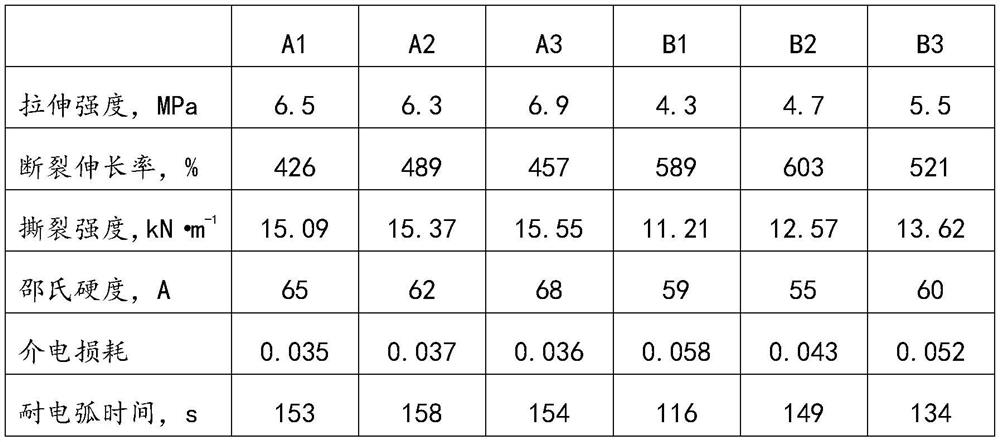Silicone rubber umbrella skirt for extra-high voltage composite insulator and preparation method thereof
A composite insulator and silicone rubber technology, applied in the field of silicone rubber materials, can solve the problems of general pollution flashover resistance, electrical corrosion loss on the surface of insulators, and large environmental impact.
- Summary
- Abstract
- Description
- Claims
- Application Information
AI Technical Summary
Problems solved by technology
Method used
Image
Examples
Embodiment 1
[0028] A method for preparing a silicone rubber shed for an ultra-high voltage composite insulator specifically includes the following steps:
[0029] (1) Put 100 parts of methyl vinyl phenyl silicone rubber raw rubber, 40 parts of Mg-SiC compound and 3 parts of hydroxyl silicone oil in a kneader, knead at 80°C for 1 hour, and then mix the modified diatomaceous earth 70 parts, 7 parts of cyclic trisilazane, 5 parts of nano-ZnO, 2 parts of titanium dioxide, 1.5 parts of dispersant and 1.5 parts of silane coupling agent were put into the kneader, vacuumed for vacuum kneading, the vacuum degree was 0.05MPa, The temperature was 160°C, and the mixture was kneaded for 3 hours to obtain a mixed rubber.
[0030] (2) Wrap the mixed rubber on an open mill, add 3 parts of vulcanizing agent phenol formaldehyde resin, thin it out, and release the sheet, then place the sheet on a flat vulcanizing machine for vulcanization and molding, and vulcanize at 160°C and 12MPa pressure After 10 minu...
Embodiment 2
[0037] A method for preparing a silicone rubber shed for an ultra-high voltage composite insulator specifically includes the following steps:
[0038] (1) Put 100 parts of methyl vinyl phenyl silicone rubber raw rubber, 80 parts of Mg-SiC compound and 5 parts of hydroxyl silicone oil in a kneader, knead at 120°C for 0.5h, and then mix the modified diatom Put 50 parts of soil, 4 parts of cyclic trisilazane, 8 parts of nano-ZnO, 5 parts of titanium dioxide, 3 parts of dispersant and 4 parts of silane coupling agent into the kneader, and vacuumize for vacuum kneading. The vacuum degree is 0.26MPa. The temperature was 120°C, and the mixture was kneaded for 2 hours to obtain a mixed rubber.
[0039] (2) Wrap the mixed rubber on an open mill, add 1 part of vulcanizing agent phenol formaldehyde resin, thin it out, and release the sheet, then put the sheet material on a flat vulcanizing machine for vulcanization molding, and vulcanize at 180°C and 10MPa pressure After 12 minutes, the...
Embodiment 3
[0046] A method for preparing a silicone rubber shed for an ultra-high voltage composite insulator specifically includes the following steps:
[0047] (1) Put 100 parts of methyl vinyl phenyl silicone rubber raw rubber, 65 parts of Mg-SiC compound and 4.3 parts of hydroxyl silicone oil in a kneader, knead at 100°C for 1 hour, and then mix the modified diatomite 58 parts, 5.7 parts of cyclic trisilazane, 6 parts of nano-ZnO, 3.8 parts of titanium dioxide, 2.2 parts of dispersant and 2.9 parts of silane coupling agent are put into the kneader, and vacuum kneading is carried out by vacuuming. The vacuum degree is 0.18MPa, and the temperature at 140°C, and kneaded for 3 hours to obtain a mixed rubber.
[0048] (2) Roll the mixed rubber on the open mill, add 2 parts of phenol-formaldehyde resin, thin it out, and release the sheet, then put the sheet material on a flat vulcanizing machine for vulcanization molding, and vulcanize for 11 minutes at 170 ° C under a pressure of 12 MPa. ...
PUM
| Property | Measurement | Unit |
|---|---|---|
| Particle size | aaaaa | aaaaa |
Abstract
Description
Claims
Application Information
 Login to View More
Login to View More - R&D
- Intellectual Property
- Life Sciences
- Materials
- Tech Scout
- Unparalleled Data Quality
- Higher Quality Content
- 60% Fewer Hallucinations
Browse by: Latest US Patents, China's latest patents, Technical Efficacy Thesaurus, Application Domain, Technology Topic, Popular Technical Reports.
© 2025 PatSnap. All rights reserved.Legal|Privacy policy|Modern Slavery Act Transparency Statement|Sitemap|About US| Contact US: help@patsnap.com


